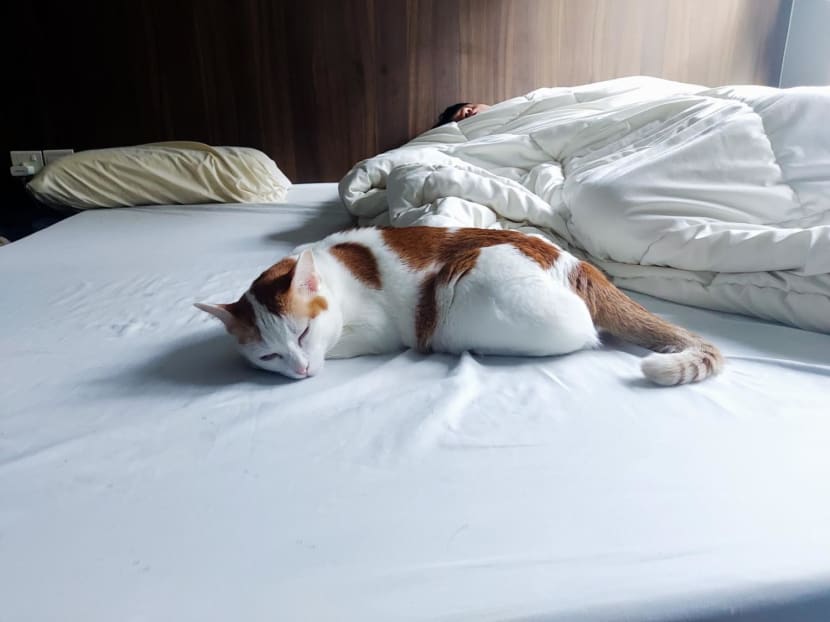Soiled sheets, broken sleep? Some S'poreans shrug off hassles to share bedrooms with beloved pets

Tofu the cat sleeping on its owner's bed.
SINGAPORE — While Lilo the English cocker spaniel is allowed in the bedroom and has slept on almost all the beds in the Lam family household, it has passed motion on only one mattress — that of 26-year-old Mathilda Lam.
And the dog has done so not once, but thrice.
“One time, I only noticed because I turned and my hand landed in the pool of poop. The other time I noticed because I heard an ominous splashing sound (of diarrhoea) ,” said Dr Lam, a medical doctor.
Still, neither Dr Lam nor the other family members think twice about letting their three-year-old furry companion sleep on their beds.
They regard those accidents “anomalies” that happened only when Lilo had tummy aches.
“Plus I mean of course we love our dog and love to cuddle with her and feel close to her,” she added.

Dr Lam is among many pet owners here who are more than happy to share a bed with their furry loved ones, despite any inconvenience that they may experience.
They were speaking to TODAY after an assistant professor of psychology recently penned a commentary about how co-sleeping with a pet may disrupt the owner’s sleep quality.
While all pet owners love and adore their four-legged friends, some draw the line at bringing the animal on their bed, citing sleeping discomfort or cleanliness concerns.
Medical experts said that while it is generally safe to share the bedroom with pets, owners should be aware of the potential health risks, particularly for those with pre-existing medical conditions.
IM-PURR-FECT BEDFELLOWS…
Even some owners who allow their pawed partners onto the bed acknowledge the inconveniences that arise, mostly around hygiene.
These may include the additional routine of wiping down or brushing their pets before sleep to reduce fur shedding. And even with this done, bed sheets need to be changed more frequently to prevent fur accumulation.
Then comes the occasional disruption to sleep due to the pet’s sensitiveness or excess energy.
Ms Nicole Kow’s miniature poodle, Coco, takes turns sleeping on the owner’s bed or its own dog bed — which is next to the human bed.
“I pretty much sleep relatively peacefully except if Coco hears an odd sound which triggers her to bark,” said the 38-year-old founder of pet goods retailer Paws of Kow.
“But also living in a home with an elderly grandmother, I do want to be alerted by any odd noises.”
Ms Iris Ng, 32, said the problem of excessive energy or noise during bedtime is a solvable problem without having to turn to “locking the pet out of the bedroom”.
“For example, scheduling play before bedtime to help release any pent-up energy and establish a routine,” says the sustainability manager who, together with her husband, is also an independent cat rescuer.
Meanwhile for Ms Risa Tang, 31, she would love nothing more than to co-sleep with her two dogs.
But as her husband dislikes having them on the bed as they "fidget in their sleep and it disrupts his sleep a lot", they sleep next to the bed instead.
"I’ve tried training the dogs to sleep only on my side of the bed but it’s not been very successful, partly because we have a queen-sized mattress and there isn’t much space to stay separated," she added.
For Ms Grace Ke, 32, while she allows her five-year-old Singapore Special to sleep in her bedroom, the dog keeps to its own bed, next to the owner's one.
“In the first week of living with us, Rufus was allowed on the bed but he is pretty warm and moves around quite a bit when he sleeps,” said the marketing manager and boxing coach at Neue Fit.
“He also likes human contact but his paws aren't exactly the most comfortable when they're pressing on your back.”
“It also affects a couple’s intimacy, I’d say,” she added.
Nonetheless, both the owners and the pet are happy with having their own beds in the shared room, said Ms Ke.
“He seems happy on his bed and hasn't ever tried to sneak onto the bed with us.”
… BUT STILL PAW-SITIVE COMPANIONS
In the eyes of most owners who spoke to TODAY, though, the benefit of cuddling with their furry ones in bed far outweighs any little inconvenience, if at all.
For example, Dr Patricia Yuen allows her five-year-old Parsons Jack Russell Terrier, Pan Pan, to share her bed as she finds dogs having an “innate ability to comfort and calm their owners down”.
Dr Yuen also sits on the fundraising and community outreach committee for the Society for the Prevention of Cruelty to Animals.
“For me, Pan Pan actually helps to stimulate dopamine release in my brain, which relaxes me and puts me in the right state of mind for bed,” said the dermatologist who runs her eponymous dermatology clinic.
Agreeing, Ms Ng added that a cat’s purring has been “scientifically linked with healing and reduced stress”, among others benefits.
“Whenever we feel anxious, relaxing beside Tofu on the bed really calms us. We find that we always sleep better beside Tofu,” she added, referring to her cat.
While being extra meticulous and regular in cleaning the bed and the pet to avoid fur accumulation may be “ma fan” to some — Mandarin for tedious — for Michelle, an owner of four cats, it is a labour of love that she does not mind at all.
“The benefits of sleeping with the cats — the comfort, heat, snuggles — far outweigh the pain of cleaning up,” said the 35 year old who works as a talent partner and declined to share her full name.
After all, like how humans turn to animals for comfort and companionship, so too do the pets to their ‘paw-rents’, said many of the owners.
“My dogs like being around us in general so it’s only natural that if they feel safe and secure with us at night, they should be able to have that by sleeping in the same room with us,” said Ms Kow.
BUT IS IT SAFE TO SHARE THE BEDROOM?
Co-sleeping with pets is generally safe, said medical doctors, though they add that owners should be aware of some risk of potential health concerns.
The most common of these would be allergic reactions.
Dr Muhd Azmi Hezan said: “If you’re allergic, I don’t recommend sleeping with your pets.”
Even though one can take antihistamines to reduce or prevent allergic reactions, it is “not 100 per cent” effective, said the general practitioner at Our Family Physician Clinic & Surgery.
“When you're sleeping, you don’t know how bad of a reaction you’ll have, since you’re unconscious,” he added.
There is also the concern over zoonotic infections — or infections that can transmit between animals and humans.
Dr Sunil Kumar Joseph, a general practitioner who runs Tayka Medical Family Clinic in Jurong, cited as an example the reported uptick of leptospirosis among dogs earlier this year.
This is a deadly disease among dogs, though no human cases of leptospirosis associated with the recent dog cases have been reported, according to news network CNA in February.
In 2017, a full-time national serviceman died in hospital after contracting the disease.
However, Dr Sunil said that concern over zoonotic infections is relatively small, as outbreaks of such diseases are “quite rare” in Singapore.
As a rule of thumb however, the doctors advised owners to still be cautious in allowing their pets in the room, especially if they have household members who are vulnerable or immunocompromised.
These may include very young children, the elderly or patients with certain conditions like diabetes, who have significantly higher rates of various wound complications.
“On the balance of probability, if you’re a normal healthy individual and you want to sleep (with your pet), I don't think it's wrong. You just have to be aware that there are certain things that can happen,” said Dr Sunil.









